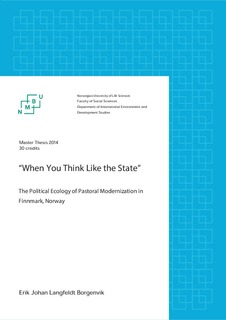| dc.contributor.author | Borgenvik, Erik Johan Langfeldt | |
| dc.date.accessioned | 2014-09-17T10:07:35Z | |
| dc.date.available | 2014-09-17T10:07:35Z | |
| dc.date.copyright | 2014 | |
| dc.date.issued | 2014-09-17 | |
| dc.identifier.uri | http://hdl.handle.net/11250/220199 | |
| dc.description.abstract | Reindeer herding in Norway is an indigenous pastoral livelihood exclusive to the Sámi
people. The regulation of this source of livelihood by the Norwegian state intensified with the introduction of a new law and policy from the late 1970s. As a result of this increased state control and management of the reindeer industry, the Ministry of Agriculture and Food, working through the Reindeer Herding Administration, has in particular focused on increasing the sustainability and productivity of the industry. This has led to an overall aim of increasing meat production through implementing a bioeconomic model called the Røros model. The model, which has been promoted through economic incentives and information work entails reductions in reindeer numbers, the altering of herd structures and increased calf slaughter. Many reindeer herders have contested these recommendations. They claim that the model undermines the traditional knowledge that has been, and still is, accumulated and reproduced through experience in the herders’ own social institutions. Through qualitative interviews with reindeer herders in Finnmark I have explored such
indigenous perspectives on herd structuring. Findings revolve around the following key
issues: the products derived from reindeer husbandry; the importance of herd structure for coping with critical climatic events; and the role of the various animal categories. While the scientific criteria of the Røros model are presented as universal criteria by the promoters of this model, the herders own criteria seem to result from local contexts, with specific adaptations conditioned by heterogeneous landscapes. The second part of the thesis is a quantitative study, which assesses the scientific uncertainty behind the claim that reindeer herding operates in a stable and predictable environment, which is a premise of the Røros model. I argue that methodology applied by the Ministry and the Reindeer Administration for calculating maximum stocking rates is unreliable. The thesis is a contribution to the political ecology of environmental governance in Norway. Political ecology provides critical tools for analyzing human-environment issues. Through perspectives provided by Scott (1998), Li (2007) and Ferguson (1994), the management of reindeer husbandry is understood as a process that simplifies reality to create legibility and to implement policy through technically defined criteria. This is a process that expands the power of bureaucracies and which promotes scientific solutions in a narrow and technical sense to problems that are imbued with questions of politics and power. The thesis is not an argument against the Røros model as such. The thesis is rather a critique of the model’s claimed general applicability. I want to direct attention to the importance of the local context and the expert knowledge that the herders hold about their own landscapes. | nb_NO |
| dc.language.iso | eng | nb_NO |
| dc.publisher | Norwegian University of Life Sciences, Ås | |
| dc.rights | Attribution-NonCommercial-ShareAlike 3.0 Norway | * |
| dc.rights.uri | http://creativecommons.org/licenses/by-nc-sa/3.0/no/ | * |
| dc.subject | VDP::Samfunnsvitenskap: 200 | nb_NO |
| dc.subject | Political Ecology | nb_NO |
| dc.subject | VDP::Landbruks- og Fiskerifag: 900::Landbruksfag: 910::Naturressursforvaltning: 914 | nb_NO |
| dc.subject | VDP::Samfunnsvitenskap: 200::Samfunnsgeografi: 290 | nb_NO |
| dc.subject | Environmental Governance | nb_NO |
| dc.subject | Finnmark | nb_NO |
| dc.subject | Reindeer herding | nb_NO |
| dc.subject | Traditional knowledge | nb_NO |
| dc.subject | Pastoralism | nb_NO |
| dc.subject | State management | nb_NO |
| dc.title | “When you think like the state” : the political ecology of pastoral modernization in Finnmark, Norway | nb_NO |
| dc.type | Master thesis | nb_NO |
| dc.source.pagenumber | 142 | nb_NO |
| dc.description.localcode | M-IES | nb_NO |

